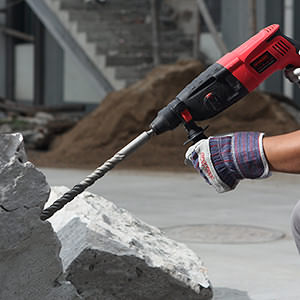What should you avoid when using powered tools?
· Do not wear gloves, loose clothing or jewelry while using revolving power tools. Tie back long hair or wear appropriate hair protection to prevent hair from getting caught in moving parts of equipment.
· Do not use a tool unless you have been trained to use it safely and know its limitations and hazards.
· Avoid accidental starting by ensuring the tool is turned off before you plug it in. Also do not walk around with a plugged-in tool with your finger touching the switch.
· Do not bypass the ON/OFF switch and operate the tools by connecting and disconnecting the power cord.
· Do not disconnect the power supply of the tool by pulling or jerking the cord from the outlet.
· Do not leave a running tool unattended. Do not leave it until it has been turned off, has stopped running completely, and has been unplugged.
· Do not use electric tools in wet conditions or damp locations unless tool is connected to a ground fault circuit interrupter (GFCI).
· Do not expose electric power tools to rain or wet conditions; wet tools increase the likelihood of electric shock.
· Avoid body contact with grounded surfaces like refrigerators, pipes and radiators when using electric powered tools; this will reduce the likelihood of shock if the operator’s body is grounded.
· Do not plug several power cords into one outlet by using single-to-multiple outlet adapters or converters (“cube taps”).
· Do not use light duty power cords.
· Stop using an electric power tool if you feel a tingle in your fingers. This is a warning that the tool is faulty and needs repair.
· Do not connect or splice extension cords together to make a longer connection: the resulting extension cord may not be able to provide sufficient current or power safely.
· Do not carry electrical tools by the power cord.
· Do not tie power cords in knots. Knots can cause short circuits and shocks. Loop the cords or use a twist lock plug.

· Never break off the third prong on a plug: replace broken 3-prong plugs and make sure the third prong is properly grounded.
· Never use extension cords as permanent wiring: use extension cords only as a temporary power supply to an area that does not have a power outlet.
· Do not walk on or allow vehicles or other moving equipment to pass over unprotected power cords. Cords should be put in conduits or protected by placing planks on each side of them.
· Do not bush away sawdust, shavings or turnings while the tool is running. Never use compressed air for cleaning surfaces or removing sawdust, metal turnings, etc.
· Do not operate tools in an area containing explosive vapours or gases.
· Do not clean tools with flammable or toxic solvents.
· Do not surprise or touch anyone who is operating a tool. Startling a tool operator could end up causing an accident or injury.







